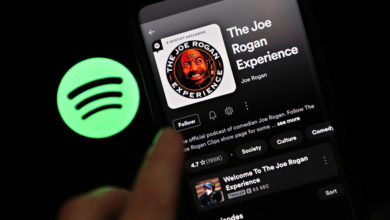Why YouTube Has Survived Russia’s Social Media Crackdown

SA new video was posted by Alexei Navalny, a jailed Russian opposition leader. It came ix days after Russian troops invaded Ukraine.
In a style part investigative journalism, part polemic, the video’s hosts report that one of President Vladimir Putin’s allies, Russian senator Valentina Matviyenko, owns a multimillion-dollar villa on the Italian seafront. Matviyenko’s lavish lifestyle is contrasted with footage showing dead Russian soldiers and images of Russian artillery striking civilian buildings in Ukraine. A voiceover calls the war “senseless” and “unimaginable.” A slide at the end urges Russians to head to squares in their cities to protest at specific dates and times. Within a matter of days, more than 4,000,000 views were recorded.
For Russians, Navalny’s YouTube channel is a key source of information that contradicts the Kremlin line. This channel is managed in Lithuania by some of Navalny’s allies who have been forced to exile from Lithuania. It boasts more than 6.4 million subscribers. It is a thorn in the side of President Vladimir Putin, and a tonic for a country where TV news is dominated by the misleading narrative that Russia’s invasion of Ukraine is actually a peace-keeping exercise.
Despite this, YouTube has largely been spared from the Kremlin’s crackdown on American social media platforms since Russia invaded Ukraine nearly a month ago.
On Monday, a court in Moscow banned Instagram within Russia, labeling its parent company, Meta, an “extremist” organization. Russia had blocked both Twitter and Facebook earlier in March after they placed restrictions on Russian state media. Data provided by eMarketer to TIME, shows that Instagram was used more than 50% by Russian internet users. The app had been a particular venue for activism: Many Russian celebrities spoke out against the invasion of Ukraine in their Instagram stories, and Navalny’s Instagram page posted a statement criticizing the war, and calling on Russians to come out in protest.
Learn More ‘It’s Our Home Turf.’ The Man On Ukraine’s Digital Frontline
But YouTube, the most popular social media platform in Russia—used by more than 75% of the country’s internet users according to eMarketer—remains accessible, even though it is an even more popular outlet for opposition activists, and has leveled similar bans against Kremlin-funded media outlets. On March 11, YouTube’s parent company Google announced that it would block Russian state-backed media globally, including within Russia. This policy was an extension of an earlier announcement that the channels would not be allowed within the European Union. “Our Community Guidelines prohibit content denying, minimizing or trivializing well-documented violent events, and we remove content about Russia’s invasion in Ukraine that violates this policy,” Google said in a statement. “In line with that, effective immediately, we are also blocking YouTube channels associated with Russian state-funded media, globally.”
This move rescinded years of the status quo. YouTube has always had the possibility to ban Russian state media outlets. That would have removed some of Russia’s most powerful tools for disinformation spreading both inside Russia and outside the country. The problem was that YouTube had to make a choice. Russia’s government had repeatedly indicated that it would retaliate against any bans of Kremlin-funded media by banning YouTube entirely within the country. That could leave many millions of Russians cut off from independent news and content shared by opposition activists like Navalny’s team. (It would also effectively delete 75 million YouTube users, or some 4% of the platform’s global total—representing a small but still-significant portion of Google’s overall profits.) The compromise was a sort of compromise: YouTube and the other social media platforms would permit RT and Sputnik on their platforms while Russia would allow websites like YouTube to continue operating in Russia.
Google had announced that it will ban Kremlin supported media from March 11. Russian YouTube users were prepared for a retaliatory ban to take YouTube offline. Yet, this ban hasn’t happened. YouTube continues to be the main way that ordinary Russians can access substantial amounts of uncensored outside information.
Photographs taken by members of the media of the screen depicting Alexei Navalny, a Russian opposition politician, at the Penal Colony in Pokrov during the prosecution of Vladimir region’s Pokrov on February 15, 2022.
Mikhail Svetlov—Getty Images
Part of the reason for YouTube’s survival amid the crackdown is its popularity, experts say. “YouTube is by far and away the most popular social media platform in Russia,” says Justin Sherman, a non-resident fellow at the Atlantic Council’s cyber statecraft initiative. VK is the Russian answer to Facebook, but this platform is much more widely used than YouTube. “When you’re talking about blocking something like Twitter, which is used by a far smaller, albeit influential subset of the Russian population, that’s a very, very different question to blocking access to the most popular internet platform in the entire country.” Twitter was used by 5% of Russia’s internet users before it was banned in the country, according to eMarketer.
Sherman believes that things are volatile and Russia is more likely to ban YouTube. For an authoritarian government like Russia’s, “part of the decision to allow a foreign platform in your country is that you get to use it to spread propaganda and disinformation, even if people use it to spread truth and organize against you,” he says. “If you start losing the ability to spread misinformation and propaganda, but people can still use it to spread truth and organize, then all of a sudden, you start wondering why you’re allowing that platform in your country in the first place.” YouTube did not respond to a request for comment.
Observers say that if Russia were to ban YouTube, it would be devastating for the country’s opposition movement. “YouTube especially has been really key for independent media and activists [in Russia] to publish their content,” says Natalia Krapiva, a Russian-speaking lawyer at the digital rights group Access Now. “It has been very influential to help people see the corruption of the government. If YouTube gets blocked, it’s going to be harder and harder for people to see that.”
YouTube: How the Kremlin manipulated it
On the same day as Navalny’s channel posted the video about Matviyenko, elsewhere on YouTube a very different spectacle was playing out. A video was posted on the channel of the Kremlin funded media outlet RT (previously known as Russia Today) by a commentator. He dismissed the evidence that Russian bombings had occurred in Ukrainian cities. She blamed “special forces of NATO countries” for allegedly faking images of bombed-out Ukrainian schools, kindergartens and other buildings.
The video, along with the rest of RT’s channel, has now been removed from YouTube. But until it was banned on March 11, RT’s channel boasted of being the “most watched news network on YouTube,” claiming to have 10 billion cumulative YouTube views. The main channel had more subscribers than 4.7million, with millions of viewers across other channels.
Before they were banned from the platform, the YouTube channels of Kremlin-funded media were some of the most significant online distributors of Russian disinformation, according to Joan Donovan, an expert on disinformation at Harvard University’s Shorenstein Center. “YouTube has, over the years, been a really important place for spreading Russian propaganda,” Donovan said in an interview with TIME days before YouTube banned Russian state-backed media.
Learn More Putin’s Disinformation Game in Ukraine: How Putin is Losing
Sherman suggests that Google only took limited measures to confront Russian state media in the 2022 period, despite being popular. He believes that this would result in retaliation and a decrease of its value as an important tool for Russian civil society. However, the company was able to comply with international pressure. In 2018, YouTube started labeling videos from RT with a notice that they are “funded in whole or in part by the Russian government.”
Still, Sherman says, “historically, Google has preferenced staying in the Russian market, and catering as needed to the Russian government to stay in the market.” In July 2021, the Russian government passed a law that would require foreign tech companies with more than 500,000 users to open a local office within Russia. A similar law was passed in India previously to make it more difficult for tech companies to remove opposition posts or accounts. The government threatened to arrest employees if they did not comply.
Google opened an office in Russia, and Google did the same. Then, in September 2021, as protests mounted against electoral fraud in recent elections, a group of apparent agents, believed to be members of the Russian intelligence service, turned up at the house of Google’s most senior executive in Moscow, according to the Washington Post. According to the Washington Post, these agents demanded that Google delete an app created by Navalny’s close allies for coordination of protest votes. Google took the app out of its store within hours. Apple also faced the same demands and removed the app form its store.
Russia’s increased risk of free expression
Experts say that Russia’s ongoing crackdown on social media platforms heralds a significant shift in the shape of the Russian internet—and a potential end to the era where the Kremlin tolerated largely free expression on YouTube in return for access to a tool that allowed it to spread disinformation far and wide.
Russian Police detain woman with poster saying “I don’t want to murder anyone”, during unannounced protest against Ukraine’s military invasion, Central Moscow, Russia, March 6,2022.
Konstantin Zavrazhin—Getty Images
Many fear that the result will create a new system in which the Russian opposition is the largest loser. “If Russians are cut off from access to YouTube, that would do enormous damage to Russian civil society,” Sherman says. “It would also push Russians more towards domestic platforms like VK, which are far more censored and far more surveilled by the Russian government than anything that the West is providing.”
Many activists are now hopeful that Putin, who is pursuing an anti-war movement in Russia, may not be willing to ban YouTube. YouTube is the most used service on the Russian Internet. It is hard to predict how the public will react to this move. “Non-politically active people also use YouTube,” Krapiva says. “If they have these services taken away from them, they might turn against the government. Or they might turn against the West.”
Here are more must-read stories from TIME





